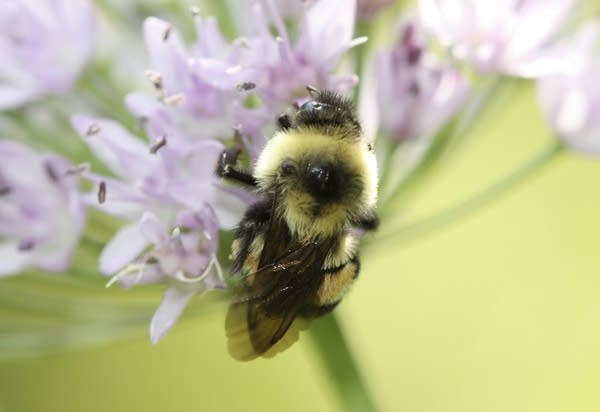Meet the rusty patched bumblebee, Minnesota's new bee ambassador

Meet Minnesota's new state bee: The rusty patched bumblebee, an endangered species you might be able to see in your own backyard.
Once widespread and abundant, the bumblebee's population experienced a precipitous population decline in the early 2000's — and Minnesota is home to a significant part of the remaining population.
"It's been lost in 90 percent of its historical range," said U.S. Fish and Wildlife Service biologist Tamara Smith, who studies endangered species. "Now it's only in 10 states, including Minnesota."
Gov. Tim Walz made the state bee designation official, when he signed state budget bills into law this week after a contentious legislative session. The designation comes along with a pledge to protect the bee, which in Minnesota is found primarily in and around the Twin Cities. And scientists say regular Minnesotans can help the population recover.
Create a More Connected Minnesota
MPR News is your trusted resource for the news you need. With your support, MPR News brings accessible, courageous journalism and authentic conversation to everyone - free of paywalls and barriers. Your gift makes a difference.
"This is the first bee in the contiguous United States to be listed as endangered," said Elaine Evans, a bumblebee expert with the University of Minnesota Bee Squad. "Because of that, we really need to raise awareness and do everything we can do to help this bee."
The bee — officially Bombus affinis — is called the rusty patched bumblebee because of the small rust-colored patch, surrounded by yellow, on its back.
It's not clear what caused the population crash in the early part of the century, but experts believe it was prompted by a combination of disease, habitat loss and pesticides.

"It's really hard to figure out what went wrong with a population, when the population has become so small," said Evans. "I'm not sure if we really do have a chance of ever solving that mystery."
Wild bees like the rusty patched bumblebee are more difficult to study than domesticated honey bees. But Smith thinks this bee deserves more attention.
"You can kind of look at it as one of the canary-in-the-coal-mine type of species, where their loss might indicate that something else is going wrong within the ecosystem in which they live. We're also noticing similar patterns with other bees and butterflies," said Smith.
Before they nearly disappeared, the rusty patched bumblebee was among the top four or five most commonly seen bumblebees in the Midwest. Now it's found consistently in only a few spots, mostly around urban areas: Chicago, Milwaukee, Iowa City and Madison.
About a third of the more than 500 reported sightings of rusty patched bumblebees last year happened in or near the Twin Cities.
Smith said the U.S. Fish and Wildlife Service depends heavily on citizen scientists who report bee sightings.
"People can have an endangered species in their in their backyard and really make a difference I think that's a pretty cool and unique thing that we have here in the Twin Cities," said Smith.
It's not clear why more of the endangered bees are found near urban areas, but it might be because people are adding more flowers to the landscape, providing critical spring and fall food sources.
"The rusty patched bumblebee needs blooming flowers that are available from early in the spring all the way through the fall," explained Evans.
"In addition, they need places to nest. If you just leave some areas of your yard undisturbed, if you are able to make a wood pile or a pile of leaves somewhere, that can be a great place for these bees to make their nest. If we do it these simple steps, we can do a lot for making sure that the rusty patched bumblebees that we do still have here can thrive and grow and recover."
The Legislature approved $900,000 over two years for grants to homeowners who add pollinator habitat to their yards. The funding will reimburse 75 percent of the cost.
Lawmakers also approved funding to continue a statewide survey of wild bees, including bumblebees.